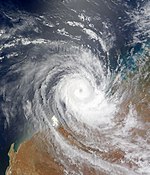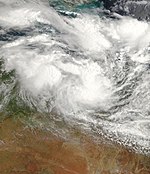2008–09 Australian region cyclone season
| 2008–09 Australian region cyclone season |

Season summary map
|
| Seasonal boundaries |
| First system formed |
17 November 2008 |
| Last system dissipated |
18 May 2009 |
| Strongest storm |
|
| Name |
Hamish |
| • Maximum winds |
215 km/h (130 mph)
(10-minute sustained) |
| • Lowest pressure |
925 hPa (mbar) |
| Seasonal statistics |
| Tropical lows |
24 |
| Tropical cyclones |
11 |
| Severe tropical cyclones |
3 |
| Total fatalities |
4 direct, 1 indirect |
| Total damage |
$103.3 million (2008 USD) |
| Related articles |
|
|
Australian region tropical cyclone seasons
2006–07, 2007–08, 2008–09, 2009–10, 2010–11
|
| Category 2 tropical cyclone (Australian scale) |
| Tropical storm (SSHWS) |
|
|
| Duration |
17 November – 22 November |
| Peak intensity |
95 km/h (60 mph) (10-min) 984 hPa (mbar) |
| Category 4 severe tropical cyclone (Australian scale) |
| Category 3 tropical cyclone (SSHWS) |
|
|
| Duration |
17 December – 28 December |
| Peak intensity |
175 km/h (110 mph) (10-min) 950 hPa (mbar) |
| Tropical low (Australian scale) |
|
|
| Duration |
21 December – 24 December |
| Peak intensity |
55 km/h (35 mph) (10-min) 1000 hPa (mbar) |
| Tropical low (Australian scale) |
|
|
| Duration |
23 December – 28 December |
| Peak intensity |
35 km/h (25 mph) (10-min) 1003 hPa (mbar) |
| Category 1 tropical cyclone (Australian scale) |
| Tropical storm (SSHWS) |
|
|
| Duration |
8 January – 12 January |
| Peak intensity |
85 km/h (50 mph) (10-min) 987 hPa (mbar) |
| Tropical low (Australian scale) |
|
|
| Duration |
11 January – 11 January |
| Peak intensity |
35 km/h (25 mph) (10-min) |
| Category 2 tropical cyclone (Australian scale) |
| Tropical storm (SSHWS) |
|
|
| Duration |
22 January – 27 January |
| Peak intensity |
95 km/h (60 mph) (10-min) 980 hPa (mbar) |
| Category 1 tropical cyclone (Australian scale) |
| Tropical storm (SSHWS) |
|
|
| Duration |
30 January – 4 February |
| Peak intensity |
75 km/h (45 mph) (10-min) 989 hPa (mbar) |
| Category 2 tropical cyclone (Australian scale) |
| Tropical storm (SSHWS) |
|
|
| Duration |
2 February – 10 February |
| Peak intensity |
95 km/h (60 mph) (10-min) 983 hPa (mbar) |
The 2008–09 Australian region cyclone season was a near average tropical cyclone season. It officially started on 1 November 2008, and officially ended on 30 April 2009. The regional tropical cyclone operational plan defines a "tropical cyclone year" separately from a "tropical cyclone season"; the "tropical cyclone year" began on 1 July 2008 and ended on 30 June 2009.
The scope of the Australian region is limited to all areas south of the equator, east of 90°E and west of 160°E. This area includes Australia, Papua New Guinea, western parts of the Solomon Islands, East Timor and southern parts of Indonesia.
Tropical cyclones in this area are monitored by five Tropical Cyclone Warning Centres (TCWCs): the Australian Bureau of Meteorology in Perth, Darwin, and Brisbane; TCWC Jakarta in Indonesia; and TCWC Port Moresby in Papua New Guinea. The Joint Typhoon Warning Center issues unofficial warnings for the region, designating tropical depressions with the "S" suffix when they form west of 135°E, and the "P" suffix when they form east of 135°E.
In October 2008 ahead of the season starting on November 1, the tropical cyclone warning centres in Perth, Darwin and Brisbane issued a seasonal outlook for their area of responsibility, which urged people to prepare for possible tropical cyclones. Within each outlook factors such as the high values of the Southern Oscillation Index, near average sea surface temperatures and the neutral El Niño–Southern Oscillation conditions were taken into account. TCWC Perth predicted within their seasonal outlook that the North-Western subregion between 105°E and 130°E would see an early start to the season. They also predicted that between 5 - 7 tropical cyclones would occur in the region during the season compared to an average of about 5 and that there was a likelihood of two tropical cyclones and one severe tropical cyclone impacting Western Australia. TCWC Darwin predicted that there might be an early start to the season within the Timor Sea and slightly above average numbers of tropical cyclones around northern Australia. They also noted that there was an even chance of having a severe tropical cyclone in the region during the season. Within their outlook TCWC Brisbane predicted that there would be a high amount of activity within the Australian Monsoon, and that the chances of a repeat of the widespread flooding rains were not great due to their being no well-established La Nina.
...
Wikipedia















